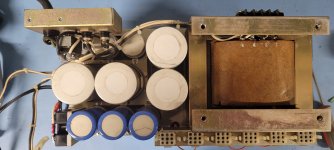I'm working on a PDP11/03, and after some digging I was able to get the power supply out of the case, and I must say it looks remarcably clean. No mouse droppings or whatever.

Overkill if you ask me, looking at the number of boards and the size and number of power connectors on the supply.
So before anything else I had to inspect the caps for leakage and polarity.

Not an easy task, I was able to remove one capacitor so I could check the polarity, inspect for leakage (it looked great!) and apply voltage to it to see what happens to it when I do.
Nothing happened which is great

This made me confident to take the next step: using a variac to slowly increase the mains voltage.
On the side of the power supply there sits a solid state relay, but since I took the supply out of the case, the on/off switch is detached, so I replaced the switch with a piece of wire.
And reading that I should never switch on a power supply without any ventilation, even when I do not draw any power from it, I took an old 12 volt computer fan and attached it to the heatsink.
I slowly increased the main voltage with the variac while keeping an eye on the voltages on the power connector used to power the system.
The voltages slowly increased as I turned up the variac, kept it for about 10 minutes before increasing about 30 volts at a time.
I noticed the 15 outlet was about twice the 5 volt pins on the connector so I figured that was okay.

Also the three LED's on the righthand side of this board started to emit red, so all's well.
But at some point when the 15 volt pin was a few volts, suddenly the voltage drops to zero and the LED's went dark

I repeated the procedure, turning the variac slowly up until the LED's go out, and I noticed that prior to the voltage drop two leds on the board flashed.
These LED's are marked: DC LO and AC LO.
That made sense! At a certain voltage the power control circuit begins doing its thing and detects a low DC and a low AC, which is considered a faulty condition and the power shuts down.
Coming to this conclusion and no magic smoke coming from the supply I was confident enough to yank the variac to 230 volt output, and there was a working power supply











